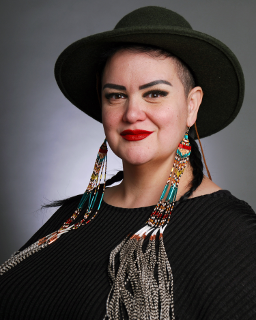New Indigenous support manager joins Faculty of Law
Sarah Kent - 29 March 2021

Tamara Pearl’s path to law will undoubtedly fuel her work championing Indigenous law students’ wellbeing as the new Indigenous student support manager at the University of Alberta Faculty of Law.
“I very much resonate with a lot of the struggles that (students) are facing,” said Pearl. “(I understand) a lot of the loneliness that comes from being trailblazers for your own communities...I was the first from One Arrow First Nation to be a Juris Doctor and then Master’s of Law graduate.”
“I want to work with the wonderful initiatives that are already underway at the University of Alberta to do what I can to support and promote these projects, as well as offering my own expertise with community engagement to aid in attracting Indigenous students to pursue law school.”
Pearl, who is Nēhiyaw (Plains-Cree) from One Arrow First Nation, grew up in inner-city Saskatoon but spent summers on reserve with family, participating in ceremony and the many community social gatherings, including round dances, Batoche Days and One Arrow First Nation’s annual powwow.
“I grew up thinking everyone did that,” said Pearl. “I assumed most people in the core neighbourhoods had these very strong connections to their reserves. I didn’t realize how lucky I was to be so strongly connected to my community.”
Pearl lived with her mother until she was 13, when she was apprehended by child protection services and spent the next few years between foster care and on the YWCA crisis floor.
At 16, she aged out of care and found herself navigating inner-city Saskatoon on her own, eventually connecting with her settler father again.
“What was a real resilience or ‘saving’ factor for me growing up was the public library system,” said Pearl. “I met people including librarians who mentored and encouraged me, but it wasn’t until my early twenties that I decided to go to university as a mature student.”
The transition to post-secondary education was challenging, said Pearl, who took out student loans and worked full time to make ends meet because band funding was limited, all while completing her degree in anthropology at the University of Saskatchewan.
Despite facing barriers, she went on to complete a JD and LLM from the University of Saskatchewan and is now undertaking a PhD in Law at the University of Ottawa.
Path To Law
Pearl was working as a teaching assistant for the Aboriginal Student Achievement Program (now Indigenous Student Achievement Pathways) at the University of Saskatchewan when she was struck by what a path to law could accomplish for her community.
“I just realized that law school was ground zero for a lot of the legislators, policy writers and legal professionals that basically inform how our government runs,” said Pearl.
“I found a passion for it — a passion for my people — that I don’t think I would have found if I didn’t learn why things were the way they were, whether it was treaty-making, treaty-honouring, discrimination barriers in past legislation and so on.”
Pearl found herself at a crossroads after completing her JD, faced with the option of articling or pursuing her calling in legal community engagement. She chose the latter, accepting a position as an executive assistant to one of the commissioners for the National Inquiry into Missing and Murdered Indigenous Women and Girls.
The community engagement at the heart of the National Inquiry ultimately formed the basis of Pearl’s master’s and doctoral research, centred on anti-dominance training in an anti-colonial framework for law school curriculum in order to help train legal practitioners for systemic change.
Pearl sees a bright future for Indigenous students in law — a future that is indebted to those who have blazed those paths.
“What I want to do is support the students in their advocacy but also in their needs for what can be done right now, what can be determined in the near future and the long-term plan on how best to support Indigenous students,” she said.